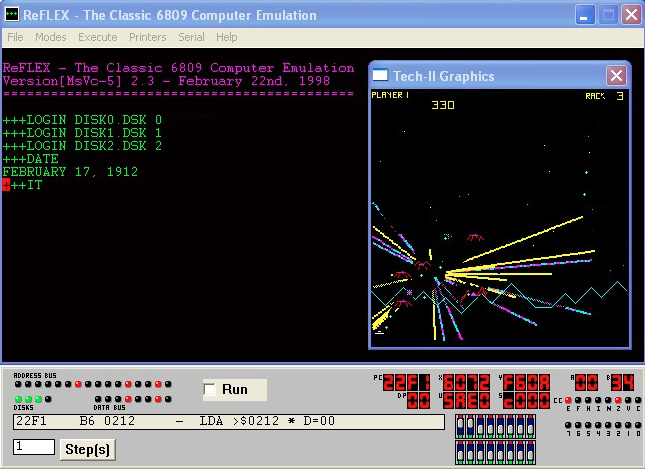§ 1 - Introduction
Reflex is a free package (previously commercial) which provides a complete emulation of a 6809 processor based computer system, running the TSC FLEX operating system over the Percom PSYMON monitor ROM with a useful command extension set. It runs under Win95; an older version is also available to run under the Amiga's OS (2.04 or higher). On any PC from a 60 MHz Pentium on up, the emulator is faster than the original computer system was.
This manual documents the emulation itself. A good place to look for documentation on much of the software in the emulation is the Flex User's Group. Here's a link to an excellent book on 6809 programming.
The 6809 is a 64k memory capable microprocessor with a decent register set and a very strong instruction set for an 8-bit CPU of its day. Motorola was the source of the design of the 6809; it was derived, somewhat loosely, from the 6800. It offered 6800 source code compatibility for the most part. The next step beyond the 6809 was the 68000 series.
FLEX is a small (Approximately 6k!) DOS which, along with CP/M and a few others, truly pioneered small personal computers. These were the systems that were already well in place when Apple Computer started in a garage. We're all tired of hearing about how Apple "started" the computer revolution. They didn't. They weren't even around at the time. Intel & MITS (the Altair 8800) started it. Period.
PSYMON is a low level system monitor that nominally is 1k. In this emulator, there is an additional 1k ROM extension I wrote which provides some additional capabilities to the monitor.
When I call the emulation "complete", I mean that I've provided...
- A comprehensive emulation of the original computer system
- All the commands and utilities you'd need to do real work
- Solid emulation
- Usable speed
If you ran FLEX in the past, you'll likely experience a strong sense of nostalgia within seconds after starting the software. Welcome to the club!
This software provides emulation of all 6809 official* instructions with the exception of CWAI & SYNC. The virtual computer which the emulator creates has 64k of memory, 2k of which is ROM, or read-only. There is also a low-level "monitor"; this is called PSYMON. It originally came from Percom corporation.
| * | There are some undocumented instructions that work, or partially work, within some versions of the 6809 chips. These are not supported in the emulator; Motorola, the architects of the 6809, never supported or admitted to these various operations. Software that depends on these features will not function as intended. Also, Hitachi created a chip called the "6309" which had some additional functionality. That functionality is not emulated. |
The software provides character I/O via emulation of a Motorola 6850 ACIA chip located at addresses $E008 and $E009, and aliased at $E004 & $E005. It provides Disk I/O via emulation of a powerful DMA disk controller that lets the Host do 99% of the work using the Host processor directly, which means that disk I/O is considerably faster under the emulation than it was for any conceivable 6809 system.
Printer support is likewise handled by the Host processor directly as a DMA operation. Under FLEX, you just use the "P" command as you usually would. There is a menu that allows selection of LPT1: through LPT4: as the output printer.
, Previous Page . Next Page t TOC i Index g Glossary
| Please consider supporting my Reflex efforts via a small PayPal donation. |
